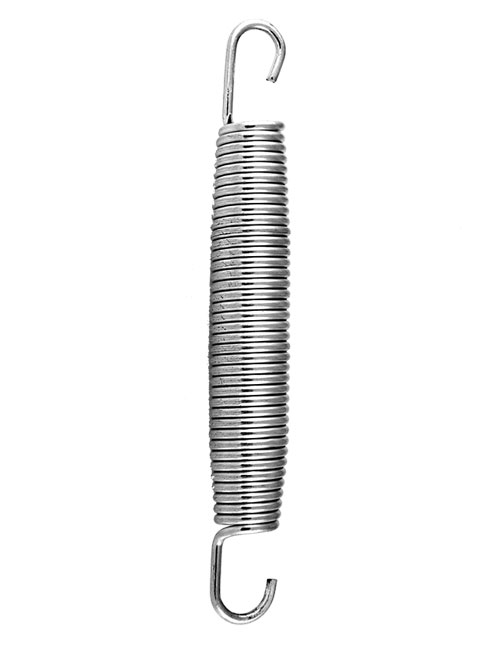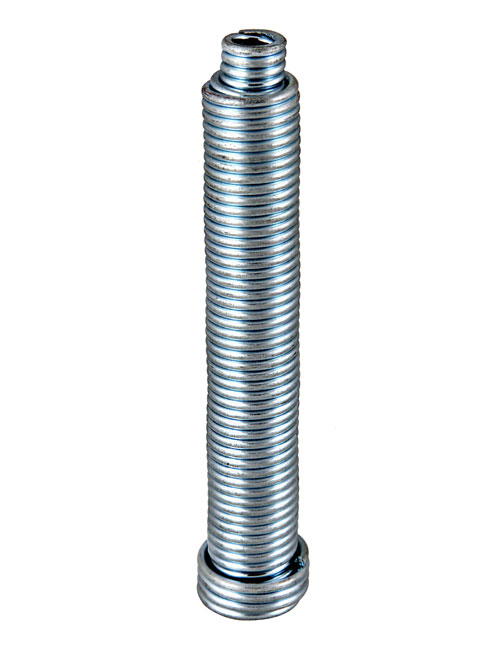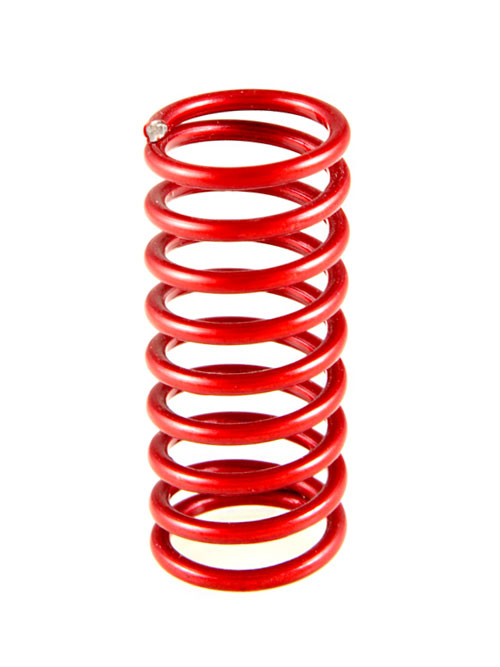Glossary of Spring Terms
 Active Coils
Active Coils
Those active coils which are free to deflect under load.
Air Spring
Spring using the elasticity of air, which is one of the fluid springs.
Angular relationship of ends
The relative position of the plane of the hooks or loops of extension springs to each other.
Arbor
A round, hardened rod or shaft upon which springs are wound., Also called a "mandrel"
Baking
Heating of electroplates springs to relieve hydrogen embrittlement.
Blue
A thin blue film of oxide on ferrous alloys, sometimes used to indicate that the material has been stress relieved.
Buckling
Bowing or lateral deflection of compression springs when compressed, related to the slenderness ratio (L/D)
 C-Type Eccentric Retaining Ring
C-Type Eccentric Retaining Ring
Eccentric retaining ring shaped like leter "C", including two types: for one-shaft-use and for in-bore-use.
C-Type Concentric Retaining Ring
Concentric retaining ring shaped like leter "C", including two types: for one-shaft-use and for in-bore-use.
Ceramic Spring
Spring made of ceramics (sintered materials mainly comprising aluminum oxide and the like) as called by its material.
Circlip
Generic term for circular springs, such as C-type retaining ring.
Closed Ends
Ends of compression springs, where pitch of the end coils is reduced so that the end coils touch.
Closed and ground ends
As with closed ends, except that the end is ground to provide a flat plane.
Closed length
See solid height
Close-wound
Coiled with adjacent coils touching
Coils per inch
See pitch
Cold Formed Spring
Spring formed in low temperature, such as the cold formed coil compression spring and the cold formed coil extension spring as called by its forming method.
Combination Spring
Combination of Multiple springs to obtain the required characteristics. (Springs may be combined in a serial or parallel way. A combination spring comprising two springs is called serial double spring or parallel double spring.)
 Composite Resin Spring
Composite Resin Spring
Spring made of composite rresin materials, as called by its material.
Compression Spring
Spring subjected mainly to a compressive force, in the narrow sense, helical compression spring.
Constant Force Spring
Spring that indicates constant load or torque despite of the deflection change.
Constant Rate Spring
Spring deflection of which is linear to the load applied.
Deflection (F)
Motion of spring ends or arms under the application or removal of an external load (P)
E-Type Retaining Ring
Retaining ring shaped like letter "E" for on-shaft-use.
Elastic limit
Maximum stress to which a material may be subjected without permanent set.
Endurance limit
Maximum stress at which any given material will operate indefinitely without failure for a given minimum stress.
Extension Spring
Spring subjected mainly to an extensive force, in the narrow sense, helical extension spring (tension spring).
Fastener Spring
Various shapes of spring for fastening.
Flat Spring
Various shapes of spring made of thin flat materials, as called by its material.
Fluid Spring
Spring using the elasticity of gas or liquid, as called by its material.
Formed Wire Spring
Various shapes of springs made of wire, as called by its material.
Free Angle
Angle between the arms of a torsion spring when the spring is not loaded
Free Length (L)
The overall length of a spring in the unloaded position.
Frequency (natural)
The lowest inherent rate of free vibration of a spring itself (usually in cycles per second) with ends restrained.
Gas Pressure Spring
Spring using the elasticity of inert gas such as Argon or Helium, which is one of the fluid springs.
Gas Spring
Spring using the elasticity of inert gas such as Argon or Helium, which is one of the fluid springs.
Gradient
See Rate (R)
Grip Ring
Retaining ring used for shafts without grooves.
Heat setting
Fixturing a spring at elevated temperature to minimize loss of load at operating temperature.
Helix
The spiral form (open or closed) of compression, extension, and torsion springs.
Hooks
Open loops or ends of extension springs.
Hot Formed Spring
Spring formed in low temperature, such as the cold formed coil compression spring and the cold formed coil extension spring, as called by its forming method.
Hot pressing
The heat setting.
Hydrogen embrittlement
Hydrogen absorbed in electroplating or pickling of carbon steels, tending to make the spring material brittle and susceptible to cracking and failure, particularly under sustained loads.
Hydropneumatic Spring
Spring using the elasticity of gas or liquid, as called by its material.
Hysteresis
The mechanical energy loss that always occurs under cyclic loading and unloading of a spring, proportional to the area between the loading and unloading load-deflection curves within the elastic range of a spring.
Initial Tension (P)
The force that tends to keep the coils of an extension spring closed and which must be overcome before the coils start to open.
Load (P)
The force applied to a spring that caused a deflection (F).
Lock Washer
Generic term for washers for locking using the spring action.
Loops
Coil-like wire shapes at the ends of extension springs that provide for attachment and force application.
Magnetic Spring
Spring using the repulsion force and attraction force by magnetism, as called by its type of function.
Mean coil diameter (D)
Outside spring diameter (O.D.) minus one wire diameter (d)
Metallic Spring
Spring made of metallic materials as called by its material.
Modulus in shear or torsion (G)
Coefficient of stiffness for extension and compression springs.
Modulus in tension or bending (E)
Coefficient of stiffness used for torsion and flat springs (Young's Modulus).
Moment (M)
See Torque
Nonferrous Metal Spring
Spring made of nonferrous metal, as called by its material.
Non-linear Spring
Spring the deflection of which is not linear to the load applied.
Non-Metallic Spring
Spring made of non-metallic materials as called by its material.
Open ends, not ground
End of a compression spring with a constant pitch for each coil.
Open ends ground
"Open ends, not ground" followed by an end grinding operation
Passivating
Acid treatment of stainless steel to remove contaminants and improve corrosion resistance.
Permanent set
A material that is deflected so far that its elastic properties have been exceeded and it does not return to its original condition upon release of load is said to have taken a "permanent set".
Pitch (p)
The distance from center to center of the wire in adjacent active coils (recommended practice is to specify number of active coils rather than pitch.
Pneumatic Spring
Spring using the elasticity of air, which is one of the fluid springs.
Preset
See Remove set.
Progressive Rate Spring
Spring the deflection of which is not linear to the load applied.
Rate (R)
Change in load per unit deflection, generally given in pounds per inch.
Remove set
The process of closing to solid height a compression spring which has been coiled longer than the desired finished length, so as to increase the apparent elastic limit.
Residual stress
Stresses induced by set removal, shot peening, cold working, forming or other means. These stresses may or may not be beneficial, depending on the application.
Retaining Ring
Circular spring for preventing the axial movement by snapping into the groove formed on the shaft or the hole. (A grip ring is used for grooveless shafts.)
Rubber Spring
Spring using the elasticity of rubbers, as called by its material.
Set
Permanent distortion which occurs when a spring is stressed beyond the elastic limit of the material.
Slenderness ratio
Ratio of spring length (L) to mean coil diameter (D).
Snap Ring
Circular spring for preventing the axial movement by snapping into the groove formed on the shaft or the hole. (A grip ring is used for grooveless shafts.)
Solid height (H)
Length of a compression spring when under sufficient load to bring all coils into contact with adjacent coils.
Spring
Mechanical element designed mainly to unitse by elasticity or distoriion of an object.
Spring index
Ratio of mean coil diameter (D) to wire diameter (d).
Spring Washer
Generic term for washers for locking using the spring action.
Squared and ground ends
See Closed and ground ends.
Squared ends
See Closed ends.
Steel Spring
Spring made of steel materials as called by its material.
Stress range
The difference in operating stresses at minimum and maximum loads.
Stress relieve
To subject springs to low-temperature heat treatment so as to relieve residual stresses.
Shot peening
A cold-wound process in which the material surface is peened to induce compressive stresses and thereby improve fatigue life.
Squareness of ends
Angular deviation between the axis of a compression spring and a normal to the plane of the ends.
Squareness under load
As in Squareness of ends, except with the spring under load.
Torque (M)
A twisting action in torsion springs which tends to produce rotation, equal to the load multiplied by the distance (or moment arm) from the load to the axis of the spring body. Usually expressed in inch-oz., inch-pounds or in foot-pounds.
Torsion Spring
twisting Spring subjected mainly to a twisting moment, in the narrow, sense, helical torsion spring. (torsion)
Total number of coils (N)
Number of active coils (n) plus the coils forming the ends.
Variable Rate Spring
Spring the deflection of which is not linear to the load applied.
Waved Spring Washer
Spring washer made by turning wire and formed into a waved shape.
Waved Washer
Spring washer made of thin ring plate on which waving is formed. (curved washer)
Wire Forming
Various shapes of springs made of wire, as called by its material.
Wire Spring
Coil spring made of wire.

